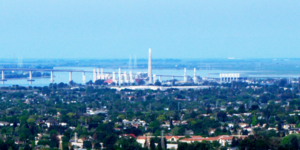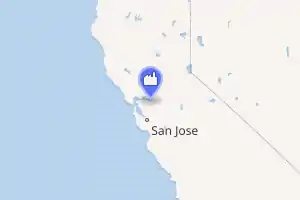Gateway Generating Station
Gateway Generating Station (GGS), formerly Contra Costa Unit 8 Power Project, is a combined-cycle[4] natural gas-fired power station in Contra Costa County, California, north of Antioch.[7]
| Gateway Generating Station | |
|---|---|
 The station, viewed from Black Diamond Mines Regional Preserve in April 2014. | |

| |
| Country | United States |
| Location | 3225 Wilbur Avenue, Antioch, California[1] |
| Coordinates | 38.0175°N 121.7587°W |
| Status | Operational |
| Construction began | 2001 |
| Commission date | January 4, 2009 |
| Owner(s) | Pacific Gas & Electric |
| Operator(s) | Pacific Gas & Electric |
| Thermal power station | |
| Primary fuel | Natural gas[2] |
| Cooling source | Dry[3] |
| Combined cycle? | Yes[4] |
| Power generation | |
| Nameplate capacity | 530MW[3][5][1] |
| Annual net output | 2,872,858 MWh[6] |

Gateway Generating Station is on the southern shore of the San Joaquin River, on Wilbur Avenue in Antioch.[1] It is one of more than 10 fossil-fuel power plants in Contra Costa County.[2]
While it was constructed as a nominally 530MW facility,[5][1] an additional 50MW of low-cost peaking capability brings its overall capacity to 580MW.[4][8] The facility is owned and operated by Pacific Gas & Electric. PG&E says that "compared to older fossil-fuel plants", Gateway Generating Station produces "dramatically less carbon dioxide for every megawatt-hour produced", and that its "dry" cooling technology causes it to use 97% less water.[3][8]
Construction
The proposal to construct the project was filed with the California Energy Commission by Mirant Delta (now GenOn Energy Holdings) in January 2000, and certified in May 2001, at which point construction began. However, by 2002, Mirant Delta was experiencing financial difficulties, and construction was suspended.[7]
In July 2005, Pacific Gas & Electric acquired the partially-constructed plant from Mirant in a settlement agreement;[3] in 2006 it was approved as a co-owner of Unit 8, and the process of filing paperwork was resumed.[7]
PG&E wanted to change the name of the project from "Contra Costa Unit 8 Power Project" to "Gateway Generating Station"; this name was chosen to show that the "plant represents the "Gateway" to the future of electric power generation" [3] and was required to file a request for this. The Energy Commission approved this request five months later. During that time, in December 2006, PG&E became the sole owner of the project.[7]
Construction finally began in February 2007; the plant construction was expected to cost about $370 million, employ as many as 400 workers at its peak, involve approximately one million worker-hours, and be providing electricity to customers by 2009.[3] It was also expected that PG&E would pay approximately $1.5 million to Contra Costa County annually in property tax.[3] It was the first new plant built by PG&E in nearly twenty years.[3] In July 2008, construction was "two-thirds" finished;[9] The gas turbines were first fired in November 2008,[7] and commercial operation began on January 4, 2009.[7]
Operation
The facility uses aqueous ammonia for both condensate hydrogen ion content (pH) control[5] and reduction of NOx emissions, through a selective catalytic reduction system.[1][5] To perform these tasks, the system has up to 18,020 gallons of aqueous ammonia solution (39,628 pounds of ammonia) in it at any given time;[5] the ammonia storage tanks are in a walled containment basin.[5]
In its first year of operation, the plant emitted 942,028 tons of CO2, 5 tons of SO2 and 83 tons of NOx,[6] while consuming 17,224,258,000 cubic feet of natural gas in order to generate 2,490,205 megawatt-hours of electricity.[6]
In 2010, the Trans Bay Cable was switched on, linking San Francisco's electrical grid with distribution infrastructure in the Contra Costa County; Gateway Generating Station was one of more than ten fossil fuel plants linked to San Francisco in this project.[2]
In June 2013, the Center for Biological Diversity submitted a legal notice of their joint intent (along with Communities for a Better Environment) to sue the Environmental Protection Agency for approving the project, claiming that its nitrogen emissions harmed local communities and "transform[ed] the chemical composition" of the nearby Antioch Dunes, causing hardship for several dozen endangered Lange's metalmark butterflies.[10][11][12] The goal of the lawsuit was to cause the EPA to reject PG&E's air emissions permit for the plant.[12] In response, PG&E said that Gateway was "state-of-the-art", and that it had entered a voluntary Safe Harbor agreement for 12 acres of its property to be used as dune habitat for the butterflies and plant species. PG&E spokeswoman Tamar Sarkissian said: "To our knowledge, we are not a party to this lawsuit".[12] Laura Horton, staff attorney at the Wild Equity Institute, said that this was "PG&E's last chance to do the right thing".[10][11] This mission was not to succeed, however; U.S. District Judge Phyllis Hamilton dismissed the suit in October, pointing out numerous issues with the filing and denying Wild Equity leave to amend its complaint.[13]
In July 2017, the New York Times identified Gateway Generating Station as an "investor-owned power plant" and noted that it was represented by the Edison Electric Institute trade association.[14]
A fall 2017 audit/inspection by Contra Costa Health Services Hazardous Materials Programs (CCHSHMP), to ensure compliance with CalARP (California Accidental Release Prevention) program requirements, found 12 corrective actions for PG&E to implement, and made 18 further recommendations. There had not been an incident related to regulated CalARP materials in the five years prior to the audit.[15]
The CCHSHMP concluded that, while the facility had a management system in place to oversee CalARP requirements, some timelines had not been met due to changes in site leadership. They also found that the facility's incident investigation, maintenance program, Safety Information program, training program and self-audit programs were implemented sufficiently, but needed to be followed on schedule and kept current. Some revisions of standard operating procedures were inaccessible, but this issue was addressed during the audit.[15]
See also
References
- "MP - Pacific Gas & Electric (PG&E) Gateway Station: Hazardous Materials Program". Contra Costa Health Services. Retrieved 2020-12-02.
- Upton, John (2011-11-19). "San Francisco May Not Be as Green as Advertised, Energy Experts Say". The New York Times. Retrieved 2020-12-02.
- Pacific Gas and Electric Company (2007-02-05). "PG&E Breaks Ground on Gateway Generating Station in Antioch". ThomasNet. Retrieved 2020-12-02.
- "Conventional Sources - PG&E Corporate Responsibility and Sustainability Report 2017". Pacific Gas & Electric. Retrieved 2020-12-02.
- Dempsey, Matt (ed.). "Gateway Generating Station". The Right-to-Know Network. The Houston Chronicle, Reynolds Journalism Institute, Missouri School of Journalism. Retrieved 2020-12-02.
- "Gateway Generating Station". Electricity data browser. U.S. Energy Information Administration. Retrieved 2020-12-02.
- "Gateway Generating Station (formerly Contra Costa Power Plant Unit 8)". California Energy Commission. State of California. Retrieved 2020-12-02.
- "Clean energy solutions". Pacific Gas & Electric. Retrieved 2020-12-02.
Compared to older fossil-fueled plants, this 580 MW station produces dramatically less carbon dioxide for every megawatt-hour produced. "Dry" cooling technology means the plant uses 97 percent less water.
- "PG&E wants to develop Tesla power plant for $850M". San Francisco Business Times. 2008-07-22. Retrieved 2020-12-02.
- Clarke, Chris (2013-07-24). "Lawsuit Filed Over Power Plant Threat to Endangered Butterfly". Public Media Group of Southern California. Retrieved 2020-12-02.
- Horton, Laura; Evans, Jonathan; Lin, Roger (2013-07-24). "Lawsuit Launched to Protect Endangered Butterfly and Communities in Contra Costa County". Center for Biological Diversity. Retrieved 2020-12-02.
- Burgarino, Paul (2014-03-26). "Lawsuit filed against EPA's non-response to PG&E's Antioch power plant permit". Mercury News. Bay Area News Group. Retrieved 2020-12-02.
- Proctor, Katherine (2015-11-25). "Greens Lose Case to Protect Rare Butterfly". Courthouse News Service. Retrieved 2020-12-02.
- Ivory, Danielle; Faturechi, Robert (2017-07-11). "The Deep Industry Ties of Trump's Deregulation Teams". The New York Times. Retrieved 2020-12-02.
- Contra Costa Health Services Hazardous Materials Programs (August 2017). "Safety Audit Summary" (PDF). Contra Costa Health Services. Retrieved 2020-12-02.
